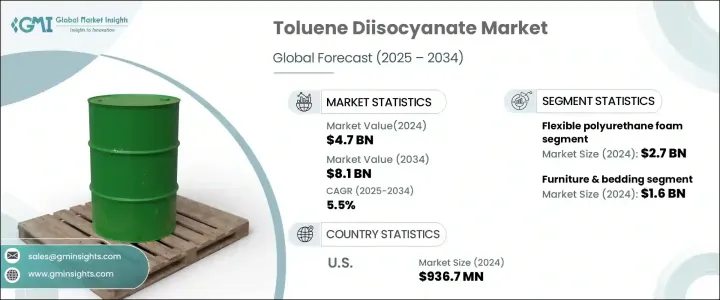
|
시장보고서
상품코드
1698241
톨루엔 디이소시아네이트(TDI) 시장 : 시장 기회, 성장 촉진요인, 산업 동향 분석, 예측(2025-2034년)Toluene Diisocyanate Market Opportunity, Growth Drivers, Industry Trend Analysis, and Forecast 2025-2034 |
||||||
세계의 톨루엔 디이소시아네이트 시장은 2024년에 47억 달러로 평가되었으며, 2025-2034년 연평균 복합 성장률(CAGR) 5.5%로 확대될 것으로 예측됩니다.
TDI는 주로 연질 폴리우레탄 폼 생산에 폭넓게 사용되고 있기 때문에 수요는 증가의 일도를 따르고 있습니다. 이러한 발포체는 가구, 침구, 자동차 용도 등 다양한 산업에서 불가결합니다. 특히 신흥 경제국에 있어서 도시화 및 주택 개발 증가에 수반해, TDI 기반 제품에 대한 요구가 큰폭으로 높아지고 있습니다.

자동차 제조의 경량 소재로의 이동은 자동차 제조업체가 연비와 성능을 향상시키는 솔루션을 요구하고 있기 때문에 TDI 기반 수요를 더욱 밀어 올리고 있습니다. 게다가 폴리우레탄 배합의 진보가 제품의 품질을 높여 시장의 확대에 기여하고 있습니다. 지속 가능성의 동향 및 규제의 압력은, 저배출 가스로 환경 친화적인 TDI 대체품으로서 자동차 메이커를 밀어 올리고 있으며, 환경 부하를 저감하는 세계의 대처와 일치하고 있습니다. 시장의 꾸준한 성장은 다양한 산업 용도의 중요한 역할과 진화하는 규제 및 소비자 기호에 대한 적응을 반영하고 있습니다.
| 시장 규모 | |
|---|---|
| 시작 연도 | 2024년 |
| 예측 연도 | 2025-2034년 |
| 시작 금액 | 47억 달러 |
| 예측 금액 | 81억 달러 |
| CAGR | 5.5% |
2024년 27억 달러로 평가된 연질 폴리우레탄 폼 분야는 2034년까지 연평균 복합 성장률(CAGR) 6.1%로 성장할 전망입니다. 이 소재는 가구, 침구, 자동차 인테리어에 널리 적용되고 있기 때문에 시장 상승의 주요 요인이 되고 있습니다. 내구성과 쾌적성을 요구하는 소비자 요구의 고조에 의해, 제조업체는 보다 뛰어난 탄력성 및 서포트성을 요구해 폼의 배합을 개량하고 있습니다. 지속 가능성이 중시되면서 바이오 기반 폼의 연구가 기세를 올리고 있습니다. 가구 분야에서의 전자상거래 성장도 휴대가 용이하고 효율적인 포장이 가능하도록 설계된 폴리우레탄 폼의 수요를 촉진하는 데 중요한 역할을 하고 있습니다.
2024년 16억 달러로 평가된 가구 및 침구 분야는 2025-2034년 6.5%의 연평균 복합 성장률(CAGR)을 나타낼 것으로 예상되고 있습니다. 도시 인구의 확대, 라이프 스타일 진화, 가처분 소득의 증가가, 계속해서 고품질의 폴리우레탄 기반 가구 솔루션에 대한 수요를 촉진하고 있습니다. 기능적이고 개성적인 가정용 및 사무실용 가구를 찾는 소비자의 기호를 반영해, 인간 공학에 근거한 디자인과 커스터마이즈 옵션이 보급되고 있습니다. 친환경 소재에 대한 관심이 높아지면서 재활용 가능한 폼 제품의 채택이 확대되고 있습니다. 홈 오피스용 가구의 수요는 소비자가 쾌적함과 생산성을 우선시하고 있기 때문에 시장 확대를 더욱 가속화시키고 있습니다.
미국의 2024년 TDI 시장 규모는 9억 3,670만 달러로 평가되었고, 예측 기간 CAGR 6%로 성장할 것으로 예상되고 있습니다. 가구, 건설, 자동차 분야에서의 수요 증가가 시장 성장에 크게 기여하고 있습니다. 건축 분야에서는 경질 폴리우레탄 폼이 단열재로서 중요한 역할을 하고 있으며, 자동차 산업에서는 TDI 기반의 재료를 활용하여 자동차의 내장을 강화하고 경량화를 도모하고 있습니다. 제조사들이 규제 상황을 충족하려고 노력하는 가운데 지속가능한 TDI 생산에 대한 투자가 시장 정세를 재구축할 것으로 예상됩니다. 그린 케미스트리 및 혁신적인 배합의 추진으로 TDI는 지속 가능한 재료 개발의 중요한 기업으로 자리매김하고 있습니다.
목차
제1장 조사 방법 및 조사 범위
- 시장 범위 및 정의
- 기본 추정 및 계산
- 예측 계산
- 데이터 소스
- 1차 데이터
- 2차 자료
- 유료 정보원
- 공적 정보원
제2장 주요 요약
제3장 업계 인사이트
- 생태계 분석
- 밸류체인에 영향을 주는 요인
- 이익률 분석
- 파괴
- 장래 전망
- 제조업체
- 유통업체
- 공급자의 상황
- 이익률 분석
- 주요 뉴스
- 규제 상황
- 영향요인
- 성장 촉진요인
- 건설 업계의 활황
- 자동차 산업의 성장
- 기술의 진보
- 업계의 잠재적 위험 및 과제
- 규제 압력
- 불안정한 원재료 가격
- 성장 촉진요인
- 잠재성장력 분석
- Porter's Five Forces 분석
- PESTEL 분석
제4장 경쟁 구도
- 서문
- 기업 점유율 분석
- 경쟁 포지셔닝 매트릭스
- 전략 전망 매트릭스
제5장 시장 추계 및 예측 : 용도별(2021-2034년)
- 주요 동향
- 연질 폴리우레탄 폼
- 경질 폴리우레탄 폼
- 코팅제
- 접착제 및 실란트
- 엘라스토머
- 기타
제6장 시장 추계 및 예측 : 최종 이용 산업별(2021-2034년)
- 주요 동향
- 가구 및 침구
- 건축
- 자동차
- 일렉트로닉스
- 포장
- 섬유
- 기타
제7장 시장 추계 및 예측 : 지역별(2021-2034년)
- 주요 동향
- 북미
- 미국
- 캐나다
- 유럽
- 영국
- 독일
- 프랑스
- 이탈리아
- 스페인
- 러시아
- 아시아태평양
- 중국
- 인도
- 일본
- 한국
- 호주
- 라틴아메리카
- 브라질
- 멕시코
- 중동 및 아프리카
- 남아프리카
- 사우디아라비아
- 아랍에미리트(UAE)
제8장 기업 프로파일
- Basf Se
- Cangzhou Dahua Group
- Covestro Ag
- Dow
- Evonik
- Ibi Chematur
- Kh Chemicals
- Merck Kgaa
- Redox
- Sabic
- Simel Chemical Industry Co., Ltd.
- Tokyo Chemical Industry
- Tosoh
- Wanhua
The Global Toluene Diisocyanate Market, valued at USD 4.7 billion in 2024, is projected to expand at a CAGR of 5.5% between 2025 and 2034. Demand for TDI continues to rise, driven primarily by its extensive use in the production of flexible polyurethane foams. These foams are essential in multiple industries, including furniture, bedding, and automotive applications. With increasing urbanization and housing developments, particularly in emerging economies, the need for TDI-based products has significantly surged.

The shift toward lightweight materials in vehicle manufacturing further fuels its demand, as automakers seek solutions that enhance fuel efficiency and performance. Additionally, advancements in polyurethane formulations are enhancing product quality, contributing to market expansion. Sustainability trends and regulatory pressures are pushing manufacturers toward low-emission, eco-friendly TDI alternatives, aligning with global efforts to reduce environmental impact. The market's steady growth reflects its critical role in diverse industrial applications and its adaptation to evolving regulatory and consumer preferences.
| Market Scope | |
|---|---|
| Start Year | 2024 |
| Forecast Year | 2025-2034 |
| Start Value | $4.7 Billion |
| Forecast Value | $8.1 Billion |
| CAGR | 5.5% |
The flexible polyurethane foam segment, valued at USD 2.7 billion in 2024, is expected to grow at a 6.1% CAGR through 2034. The material's widespread application in furniture, bedding, and automotive interiors makes it a key contributor to the market's upward trajectory. Increasing consumer demand for durability and comfort has prompted manufacturers to refine foam formulations for better resilience and support. With a greater emphasis on sustainability, research into bio-based foams has gained momentum. The growth of e-commerce in the furniture sector has also played a crucial role in driving demand for polyurethane foams designed for easy transport and efficient packaging.
The furniture and bedding segment, valued at USD 1.6 billion in 2024, is anticipated to register a 6.5% CAGR from 2025 to 2034. Expanding urban populations, evolving lifestyles, and higher disposable incomes continue to drive demand for high-quality polyurethane-based furniture solutions. Ergonomic designs and customization options are becoming more prevalent, reflecting consumer preferences for functional and personalized home and office furniture. The increasing focus on eco-friendly materials has led to greater adoption of recyclable foam products. The demand for home office furniture has further accelerated the market's expansion, as consumers prioritize comfort and productivity.
In the United States, the TDI market was valued at USD 936.7 million in 2024 and is expected to grow at a 6% CAGR over the forecast period. Rising demand from furniture, construction, and automotive sectors contributes significantly to market growth. In construction, rigid polyurethane foam plays a crucial role in insulation, while the automotive industry leverages TDI-based materials to enhance vehicle interiors and reduce weight. As manufacturers strive to meet regulatory standards, investments in sustainable TDI production are expected to reshape the market landscape. The push toward green chemistry and innovative formulations is positioning TDI as a key player in sustainable material development.
Table of Contents
Chapter 1 Methodology & Scope
- 1.1 Market scope & definitions
- 1.2 Base estimates & calculations
- 1.3 Forecast calculations
- 1.4 Data sources
- 1.4.1 Primary
- 1.4.2 Secondary
- 1.4.2.1 Paid sources
- 1.4.2.2 Public sources
Chapter 2 Executive Summary
- 2.1 Industry synopsis, 2021-2034
Chapter 3 Industry Insights
- 3.1 Industry ecosystem analysis
- 3.1.1 Factor affecting the value chain
- 3.1.2 Profit margin analysis
- 3.1.3 Disruptions
- 3.1.4 Future outlook
- 3.1.5 Manufacturers
- 3.1.6 Distributors
- 3.2 Supplier landscape
- 3.3 Profit margin analysis
- 3.4 Key news & initiatives
- 3.5 Regulatory landscape
- 3.6 Impact forces
- 3.6.1 Growth drivers
- 3.6.1.1 Booming construction industry
- 3.6.1.2 Automotive sector growth
- 3.6.1.3 Technological advancements
- 3.6.2 Industry pitfalls & challenges
- 3.6.2.1 Regulatory pressures
- 3.6.2.2 Volatile raw material prices
- 3.6.1 Growth drivers
- 3.7 Growth potential analysis
- 3.8 Porter's analysis
- 3.9 PESTEL analysis
Chapter 4 Competitive Landscape, 2024
- 4.1 Introduction
- 4.2 Company market share analysis
- 4.3 Competitive positioning matrix
- 4.4 Strategic outlook matrix
Chapter 5 Market Estimates & Forecast, By Application, 2021-2034 (USD Million) (Tons)
- 5.1 Key trends
- 5.2 Flexible polyurethane foam
- 5.3 Rigid polyurethane foam
- 5.4 Coatings
- 5.5 Adhesives and sealants
- 5.6 Elastomers
- 5.7 Others
Chapter 6 Market Estimates & Forecast, By End Use Industry, 2021-2034 (USD Million) (Tons)
- 6.1 Key trends
- 6.2 Furniture & bedding
- 6.3 Construction
- 6.4 Automotive
- 6.5 Electronics
- 6.6 Packaging
- 6.7 Textiles
- 6.8 Others
Chapter 7 Market Estimates & Forecast, By Region, 2021-2034 (USD Million) (Tons)
- 7.1 Key trends
- 7.2 North America
- 7.2.1 U.S.
- 7.2.2 Canada
- 7.3 Europe
- 7.3.1 UK
- 7.3.2 Germany
- 7.3.3 France
- 7.3.4 Italy
- 7.3.5 Spain
- 7.3.6 Russia
- 7.4 Asia Pacific
- 7.4.1 China
- 7.4.2 India
- 7.4.3 Japan
- 7.4.4 South Korea
- 7.4.5 Australia
- 7.5 Latin America
- 7.5.1 Brazil
- 7.5.2 Mexico
- 7.6 MEA
- 7.6.1 South Africa
- 7.6.2 Saudi Arabia
- 7.6.3 UAE
Chapter 8 Company Profiles
- 8.1 Basf Se
- 8.2 Cangzhou Dahua Group
- 8.3 Covestro Ag
- 8.4 Dow
- 8.5 Evonik
- 8.6 Ibi Chematur
- 8.7 Kh Chemicals
- 8.8 Merck Kgaa
- 8.9 Redox
- 8.10 Sabic
- 8.11 Simel Chemical Industry Co., Ltd.
- 8.12 Tokyo Chemical Industry
- 8.13 Tosoh
- 8.14 Wanhua



















